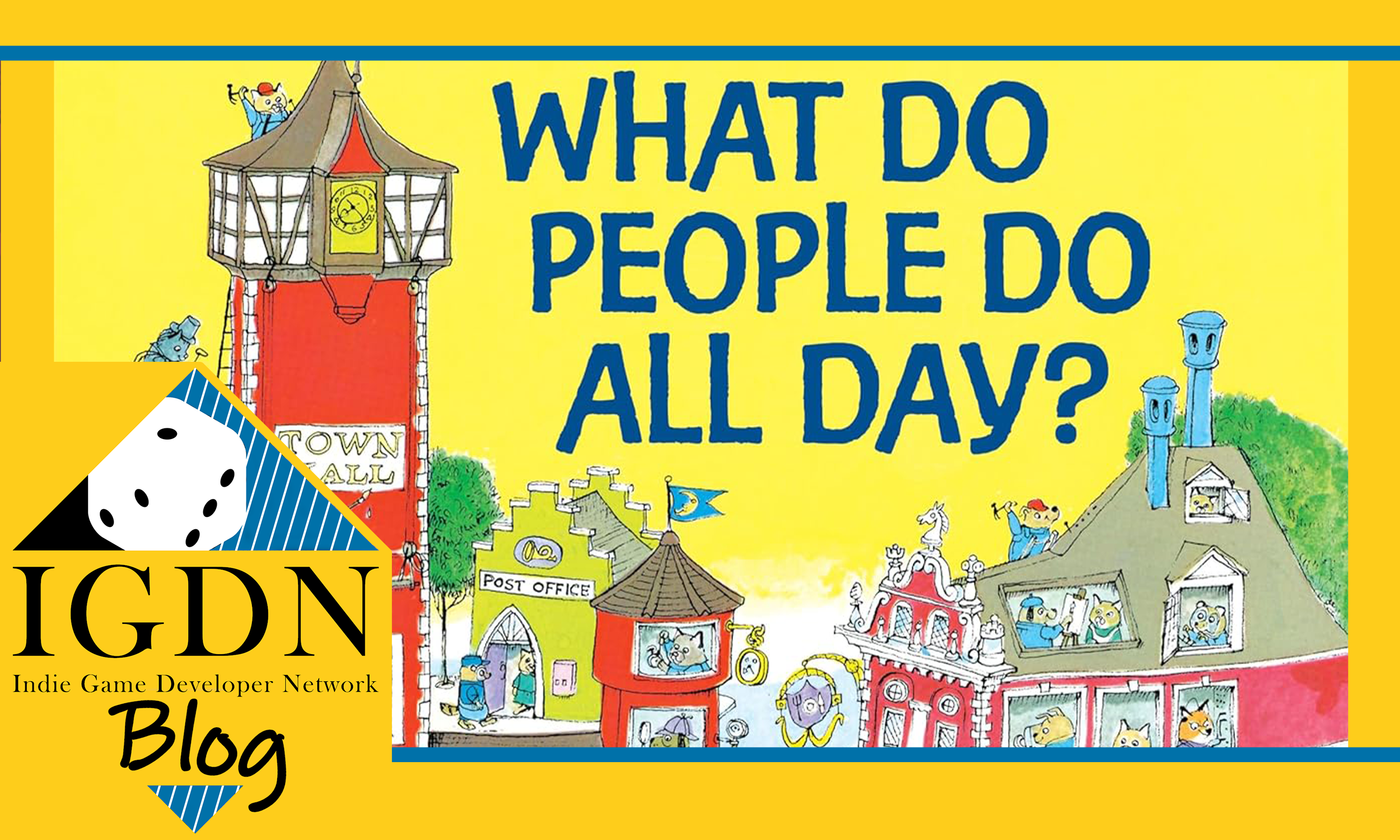World Building For Game Designers
Cover image for What Do People Do All Day by Richard Scarry (Golden Books, 1968)
World Building For Game Designers
Lesson Twelve: The Richard Scarry Principle
Steve Dee
WBGD is a series of lessons on world building in general and for game designers in particular by multi-award winning game designer and world-builder Steve Dee. Each lesson stands alone or can be read in a series. Each entry ends with an exercise for the reader to stretch their world building skills, examine their world and look for ways to improve it, or as a prompt to solve problems they have encountered in their creations.
My references are getting as old as I am but growing up as a child we had the works of Richard Scarry and I loved them. Scarry wrote and illustrated over 300 books beginning in 1949 and later in his life his works were turned into TV shows, too. His big break came with The Best Word Book Ever in 1961 but for many of us we were particularly fond of his depictions of real life and the words for those things in books like Busy Busy Town and Busy Busy World. These and other works were set in the titular Busy Town and showed lots of anthropomorphic animals out and about doing things. The appeal was lots of action-packed pictures that were fun to look at for a long time and also explained to children how the world worked.
My favourite and by far the one with the best title asked the burning question: What Do People Do All Day?
As you have likely guessed, this is a key question of all worldbuilding. Back in lesson one we talked about how worlds have a purpose and that in stories and games, that purpose is to be inhabited by key characters who get involved in narratives. They face conflicts and forces set against them and try to overcome those forces with the means at their disposal. And as we said in lesson two, the most enduring settings are typically grounded in these struggles. Star Wars is about fighting the rebellion and discovering your identity. Star Trek puts it right up front: to boldly go and seek things out. That is what they do all day.
It sounds obvious! Of course, if you make a story you’ll give the characters something to do; of course if you make a game you would have an objective. But you’d be surprised how often this gets missed, or is given short shrift, especially in RPGs. The World of Darkness games often depend on having a great GM or the right group because the rules are very clear on who you are but not always on what you are all doing. One of the reasons D&D works pretty well is everyone knows the game’s purpose—kill people, take their stuff, and sell it to get better stuff to kill better people. That’s a strong game loop—but what D&D lacks is a world with a strong reason behind this, and that leads to Murder Hobos. Compare this to Warhammer or Earthdawn where “Adventurer” is a concept written into the setting—just as Shadowrunner is in Shadowrun. This is what we’re talking about—building the game motivation into the world.
Sometimes designers just assume this is obvious but haven’t made it so, or assume the players will add it themselves, consciously or unconsciously. Players will of course respond to the mechanics: they will generally move their sprite left to right, collect things that benefit them and avoid things that disadvantage them, and they don’t need a reason to do that except to get further along. Yet there are reasons and context that a setting can so easily provide. The mechanics of Space Invaders told you to shoot the squiggly things but in two words the game told you the all important why: they were invading, from space.
Sometimes, the reason is too narrowly tied to the character. We know Mario has to rescue the Princess but as the setting has been expanded into so many other versions and media the question arises about why she keeps getting captured and why it’s always Mario who has to deal with it. Where are the cops in Super Mario World? Why don’t they stop Bowser? That’s a serious question that comes from old school horror film writing: if you don’t start with a reason why the characters can’t just call the cops in act two, it will feel cheap when you write around that. So you start at the abandoned cabin in the woods accessible by only one rickety bridge. Yes, Mario works as a game but nobody has ever praised rainbow road for its world building.
It is this concept of the larger world as well that is the “Richard Scarry Principle”. A well-built world is one where not just the heroes have a clear definition of what kind of things they do, and a justification for it. Of course the hero will go into the haunted house to save their loved ones but what is everyone else doing meanwhile? Texas Chainsaw Massacre isn’t set in midtown Dallas because then the plot wouldn’t work—people would interfere. So yes: every single person in Busy Town needs to have a thing they do that works to build the plot and structure that your game follows. This is true no matter if your setting is tight in scope—your setting might be about powerful god-like corporations, say, or set entirely inside a remote lighthouse, or be just one ghost killing guy in a maze with four ghosts. But there’s always something off-stage that needs to be thought about, to make sure those settings have meaning and weight. Somebody has to work in the factories, or row you to the lighthouse. Somebody killed those ghosts. Heck, was it Pacman who did it? Are they haunting him for revenge?
One reason that superheroes tend to be popular for games is that these questions are well answered by the genre already. Not only do we know what superheroes do all day (save people, solve mysteries, punch the mentally ill etc), that very question is often discussed, sometimes inside the comics themselves. Also, we know what the rest of the people in the setting are doing: they are being rescued, being used as bargaining chips by supervillains, discovering secret identities, getting too emotionally involved, and also sometimes hating the hero or judging them for their mutant nature. Go back and watch the first two Raimi Spider-man films and look at how much those films feature everyday citizens of New York and how much they matter to the story and to the character of Spider-man.
The characters and the setting of a strong world are made up of all the people in Busy Town. So you need to know what all those people are up to. Once you strike your keynotes and bring your ideas together, this is the question you need to get down on the page, starting with the key figures in the game, and working outwards. And we’ll talk about those first steps to actual construction next time.
Exercise: Get a big piece of paper and draw a scene from your world. I don’t care if you can’t draw, this is important. Stick figures is fine. Draw in some protagonists or heroes. What are they doing? Now imagine everyone around them. Pick a populated scene. See if you can fill the paper with all the people they might encounter or have encountered in the past or are just in the background that they might never encounter. Aim for at least a dozen non-protagonists. Draw each one. Give them a name, and a job, and a brief description. How do they interact or not interact with the story? Why or why not?
Fortunately for the author, this series is now under discussion to be
turned into a book from a major publisher. Unfortunately, for you, the
reader, this means this the series has to end with this installment. I
hope it has been inspiring to you and helped you get inspired,
organize your thoughts and strike your keynotes!
This article is part of the Indie Game Developer Network's blog series. The opinions and views expressed in this article are those of the author and do not necessarily reflect the opinions and views of the IGDN or its members.

